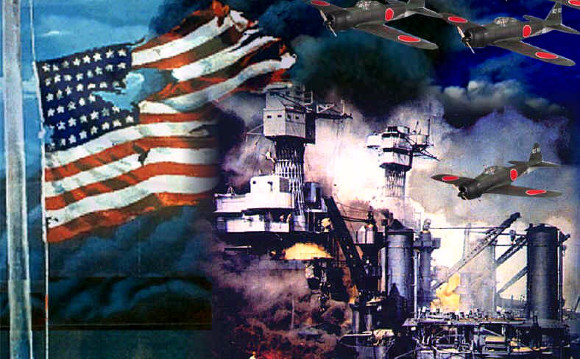The next key event of World War II was the Japanese attack on Pearl Harbor on Dec 7, 1941. This surprise attack on the American fleet inflicted a crippling blow on the United States Navy. It left over 3500 people dead, 350 American planes destroyed, and 8 battleships sunk or severely damaged. Many smaller ships were destroyed as well.
While this was a devastating attack, it did not have the effect that the Japanese High Command had hoped for. Their goal was that with one decisive strike, the US Navy would be destroyed and would cease to be a threat. While the Japanese attack did do tremendous damage, not a single US aircraft carrier was in port at the time. These aircraft carriers would soon be responsible for the American Navy’s offensive thrust. Also, most of the port facilities were undamaged in Pearl Harbor. These would play a large role in the war effort. Due to America’s advanced technological skill, all but three of the sunk or damaged ships were repaired and restored to duty in the fleet. Most importantly, the United States had been brought into the war and, as the Axis Powers would see, a united and determined America would become their toughest enemy.
One of the most decisive battles in World War II was the Battle of Midway. In June of 1942, the United States Navy was able to draw the Japanese Navy into the open. The Japanese hoping that if they could engage the US Navy they could deliver the final, crippling blow that they had not been able to land at Pearl Harbor. Instead, US Rear Admiral Spruance was able to locate the Japanese Navy first and launch the first attacks. This became the first battle in which a naval battle was dominated by air power. When the battle was over, US Naval aircraft had sunk four of the Japanese aircraft carriers. The Japanese also lost a number of planes and experienced pilots. The United States Navy suffered the loss of one aircraft carrier, the USS Yorktown. This was an important victory for the US forces. First of all, the Japanese Navy had lost half of their carrier fleet. They would never again be a dominant force in the war. Also, for the US, this victory was important for the home front. Pearl Harbor was still fresh on people’s minds and this defeat of the Japanese at Midway was the first of many victories that would mark the path towards ultimate victory for the United States and their allies.
In the European theater of war, the Battle of the Bulge was another key event. About six months previous to this, the allies had successfully invaded Europe with the goal of liberating it from the Axis powers. In December of 1944, Hitler launched a large counteroffensive over a line of several hundred miles. This was a last ditch effort by the German High Command to gain a victory over the allies or at least be in a position to ask for more favorable surrender At first, the Germans overwhelmed the allied forces. The offensive pushed forward about fifty miles. Rather than panicking, General Eisenhower saw this as an excellent opportunity to counterattack. The Germans had over-extended themselves and as the allies organized for a counteroffensive, the German casualties increased. The Germans ended up suffering over 100,000 casualties and a defeat that they would never recover from.
A last key event of World War II that will be mentioned was the dropping of atomic bombson Hiroshima and Nagasaki Japan. As the United States contemplated an attack on the mainland of Japan, predicted casualty rates were as high as one million for the allied forces. When President Truman learned that the atomic bomb was available to be used, he made the difficult decision and ordered that the bombs be dropped. On Aug 6, 1945, a United States B-29, the Enola Gay, dropped an atomic bomb on Hiroshima. 70,000 people were killed from the blast. On Aug 9, a second bomb was dropped on Nagasaki killing 80,000 people. After the second bomb, the Japanese High Command surrendered on Aug 14, 1945. The morality of Truman’s decision has been questioned for over fifty years. There is no question that the decision to use the atomic bomb hastened the end of the war and save American lives.
This article has only scratched the surface of looking at key events of World War II. There are many other events that could be discussed. These events, however, do provide the reader with an excellent time line of the war, as well as looking at the most significant moments in this terrible conflict.
My wife, Annie, and I are serving the Lord in Brazil. Would you consider becoming a part of our support team? Just click here to get started! Obrigado!
